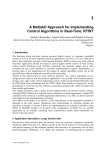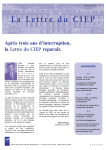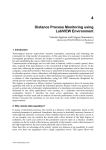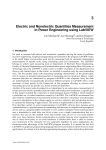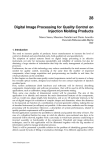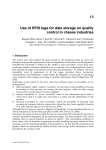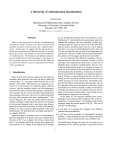Download Security Analysis of the RFID Authentication Protocol using
Transcript
0
6
Security Analysis of the RFID Authentication
Protocol using Model Checking
Hyun-Seok Kim, Jin-Young Choi, and Sin-Jae Lee
Korea University
Republic of Korea
1. Introduction
In RFID security(Gildas), few mechanisms focus on data protection of the tags, message
interception over the air channel, and eavesdropping within the interrogation zone of the
RFID reader(Sarma et al.a)(Weis et al.). Among these issues, we will discuss two aspects on
the risks posed to the passive party by RFID , which have so far been dominated by the topics
of data protection associated with data privacy and identity authentication between tag and
reader.
Firstly, the data privacy problem states that storing person-specific data in an RFID system
can threaten the privacy of the passive party. This party might be, for example, a customer or
an employee of the operator. The passive party uses tags or items that have been identified as
tags, but the party has no control over the data stored on the tags.
Secondly, the authentication will be carried out when the identity of a person or a program is
checked. Then, on that basis, authorization takes place, i.e. rights, such as the right of access
to data are granted. In the case of RFID systems, it is particularly important for tags to be
authenticated by the reader and vice-versa. In addition, readers must authenticate themselves
to the backend, however in this case there are no RFID-specific security problems.
There have been some approaches focusing on the RFID privacy and authentication issues,
including killing tags at the checkout, renaming the identifier of the tag, physical tag
password, hash encryption, random access hash and hash based ID variation. The last
three approaches of these will be discussed in detail in this chapter. We will not discuss
the remaining approaches in this chapter as they are physical solving approaches. The
last three approaches are security protocols(Ryan & Schneider) that play the essential role
of minimizing the burden of privacy and authentication problems. As with any protocol,
the security protocol comprises a prescribed sequence of interactions between entities, and
is designed to achieve a certain end. Security protocols are, in fact, excellent candidates for
rigorous analysis techniques: they are critical components of distributed security architecture,
very easy to express, however, extremely difficult to evaluate by hand.
Formal methods play a very critical role in examining whether a security protocol is
ambiguous, incorrect, inconsistent or incomplete. Hence, the importance of applying formal
methods, particularly for safety critical systems, cannot be overemphasized. There are two
main approaches in formal methods, logic based methodology (Gong et al.), and tool based
methodology (Hoare)(Lowe)(FDR). In this chapter, we specify hash based RFID security
protocols(Sarma et al.a) as the previous work that employs hash functions to secure the RFID
www.intechopen.com
114
Ubiquitous Computing
communication using Casper (A Compiler for Security Protocol Analyzer)(Lowe) specifying
tool. Then we verify whether or not it satisfies security properties such as secrecy and
authentication using the FDR (Failure Divergence Refinement) model checking tool(FDR).
After running the FDR tool, we reconfirm the existence of known security flaws in this
protocol and propose the schemes of two security protocols for secure RFID communication.
The contribution of this chapter is in analyzing the secure authentication protocols and
designing new security protocols that could be widely researched in RFID systems. Therefore
we provide a way for all methods, specifically Casper and FDR, which have been developed
over the last decade by the theoretical community for the analysis of cryptographic protocols
to be able to analyze RFID privacy and authentication problems. This especially applies to the
new security protocols proposed in this chapter, which require read access control. If a reader
requests a tag’s ID, then the tag has to firstly identify that the reader is authenticated. In the
process of authentication, the tag sends out a random number. The reader then responds to
the tag with a function value of the random number and its own ID. The reader’s output
for each query changes, meaning that even if the output is eavesdropped, the adversary can
not pass the authentication in the next query. The random number based authentication can
prevent spoofing and man-in-the-middle attacks.
This chapter is organized as follows. In brief, Section 2 describes related work on RFID
privacy and authentication schemes. Section 3 describes how RFID security protocols can be
modeled in CSP (Communication Sequential Processes)(Hoare), generated by using Casper.
Our analyzed results of the protocols will be described in Section 4. The proposed hash
based and challenge response based security protocols are presented in Section 5. Finally,
the conclusion and future work are addressed in the last section.
2. Background
2.1 The components of RFID system
RFID systems(Sarma et al.a)(Weis et al.) are made up of three main components, that we
briefly describe as follows:
1. Transponder or RFID Tag In an RFID system, each object will be labeled with a tag. Each
tag contains a microchip with some computation and storage capabilities, and a coupling
element, such as an antenna coil for communication. Tags can be classified according
to two main criteria: - The type of memory: read-only, write-once read-many, or fully
rewritable. - The source of power: active, semi-passive, and passive.
2. Transceiver or RFID Reader RFID readers are generally composed of an RF module, a
control unit, and a coupling element to interrogate electronic tags via RF communication.
Readers may have better internal storage and processing capabilities, and frequently
connect to back-end databases. Complex computations, such as a variety of cryptographic
operations, may be carried out by RFID readers, as they usually do not suffer from the
same limitations as those found in modern handheld devices or PDAs.
3. Back-end Database or Host The information provided by tags is usually an index to a
back-end database (pointers, randomized IDs, etc.). This limits the information stored in
tags to only a few bits, typically 96, which is a sensible choice, due to severe tag limitations
in processing and storing. It is generally assumed that the connection between readers
and back-end databases is secure, because processing and storing constraints are not as
constrained in readers, and therefore common solutions such as SSL/TLS can be used.
www.intechopen.com
Security Analysis of the RFID Authentication Protocol using Model Checking
115
2.2 Related work with security problem in RFID
There have been many papers in the literature that attempt to address the security concerns
raised by the use of RFID tags in RFID system. The last three approaches outlined below are
discussed in details in this chapter. We will not discuss the remaining approaches since they
are physical solving approaches.
2.2.1 Kill tag
The Auto-ID Center explicitly designed the EPC(Electronic Product Code)
(EPCGLOBAL INC.) kill command as a pro-privacy technology. The designers realized
that EPC tags might be irretrievably embedded in consumer devices and consumers might
not want to be tracked. They viewed killing EPC tags at the point-of-sale as an easy way out
of the apparent privacy dilemma. The underlying principle is that “dead tags don’t talk”.
As an alternative to killing EPC tags, tags can also be attached to a product’s price tag and
discarded at the point-of-sale.
2.2.2 Renaming approach
Even if the identifier emitted by an RFID tag has no intrinsic meaning, it can still enable
tracking. For this reason, merely encrypting a tag identifier does not solve the problem of
security. An encrypted identifier is itself just a meta-identifier. It is static and, therefore, like
any other serial number, is subject to tracking. To prevent RFID-tag tracking, it is necessary
that tag identifiers be suppressed, or that they change over time.
2.2.3 Tag password
Basic EPC(EPCGLOBAL INC.) RFID tags have sufficient resources to verify PINs or
passwords. At first glance, this appears to be a possible vehicle for privacy protection: A
tag could emit important information only if it receives the right password. The paradox here
is that a reader doesn’t know which password to transmit to a tag unless it knows the tag’s
identity. Passwords might still prove useful in certain environments. For example, retail stores
could program tags at checkouts to respond to a particular password permitted by the RFID
network in a consumer’s home. This would protect consumersaŕ
˛ privacy between a store and
their homes. If consumers want to use RFID tags in multiple environments, however, they
would face a challenging password management problem.
2.2.4 The hash lock scheme
A reader defines a “Lock” value by computing lock = hash(key)(Sarma et al.a) where the key
is a random value. This lock value is sent to a tag and the tag will store this value into its
reserved memory location (i.e. a metaID value), then the tag will automatically enter into the
locked state. To unlock the tag, the reader needs to send the original key value to the tag, and
the tag will perform a hash function on that key to obtain the metaID value. The tag then has
to compare the metaID with its current metaID value. If both of them match, the tag unlocks
itself. Once the tag is in unlocked state, it can respond with its identification number such
as the EPC(EPCGLOBAL INC.) to readers’ queries in the forthcoming cycles. This approach
makes it simple and straightforward to achieve data protection, i.e. the EPC code stored in the
tag is being protected. Only an authorized reader is able to unlock the tag and read it, then
lock the tag again after reading the code. This scheme will be analyzed in this chapter in detail
in Section 4.1.
www.intechopen.com
116
Ubiquitous Computing
2.2.5 The randomized hash lock scheme
This is an extension(Weis et al.) of the hash lock(Sarma et al.b3) scheme based on Pseudo
Random Functions (PRFs). An additional pseudo-random number generator is required to
embed into tags for this approach. Presently, tags respond to reader queries by a pair of
values (r, hash(IDk r)) where r is the random number generated by a tag, IDk is the ID of
the k-th tag among a number of tags in ID1, ID2, . . ., IDk, . . ., IDn. For reader queries, the
tag returns two values. One is the random number. The other is a computed hash value based
on the concatenation() on its own IDk and r. Once the reader gets two values, it retrieves
the current N number of ID (i.e. ID1, ID2, . . ., IDn) from the backend database. The reader
performs the above hash function on each ID from 1 to n with r until it finds a match. When
the reader finds a match, the reader is able to identify that tag k is on its tag’s ID list (i.e.
tag authentication). The reader will then send the IDk value to the tag for unlocking it. This
scheme also will be analyzed in detail in Section 4.2.
2.2.6 The hash based ID variation scheme
Henrici-Müller(Henrici & Muller) propose a 4-round protocol for low-cost RFID systems
based on a one way hash function and a random number generator. The protocol begins as
the reader queries the tag, and the tag responds with its hashed identification and current
transaction number. The response is forwarded by the reader to the back-end server for
validation. To identify the tag, the server checks the validity of the identifying information
of the tag. The server then concludes by sending a random number to the tag so that the tag’s
identification is refreshed and synchronized. This scheme also will be analyzed in detail in
Section 4.3.
3. Modeling RFID security protocols in CSP
In this section we describe how the security protocol of the RFID system is modeled using
CSP(Communication Sequential Processes)(Hoare) and how this model allows us to reason
about it. We denote R as Reader, T as Tag and m as Message, for figuring out the RFID system.
3.1 The message datatype
The datatype Message represents the messages exchanged between the different agents. It
is based on a set of atoms called Atom where the set of Key (contains session keys used in
RFID), Nonce and Text(for Authenticating between Reader and Tag) are defined as subsets of
the atom set (Key ⊆ Atom, Text ⊆ Atom and Nonce⊆Atom). In addition, we define HashFn to
be the set that contains all the available cryptographic hash functions. The datatype Message
is composed of encrypting, hashing, sequencing and the atomic value in the Atom and is
defined by:
Message ::= Encrypt.Key.Message | Hash.HashFn.Message | Sq.Message* | Atom.Atom
In this chapter we use the Casper notation of writing {m}k for Encrypt.k.m. We use H(|m|)
for Hash.H.m and abbreviate Sq.<m1 ,. . . ,mn > to <m1 ,. . . ,mn >. For example, we denote
the construct Encrypt.k.(Sq.<a,na >) by {a,na }k .
3.2 Trustworthy agents
Every agent taking part in the protocol is modeled as a CSP process. (An agent can also be
internalized in the intruder deduction set (Broadfoot & Roscoe), but for now we assume that
all honest agents are implemented as CSP processes). We define the process PR , denoting
agent R, using the following events:
www.intechopen.com
Security Analysis of the RFID Authentication Protocol using Model Checking
117
• send.R.T.M - symbolizes agent R sending message M to agent T.
• receive.T.R.M - symbolizes agent T receiving message M apparently from R.
In addition, we define the following events for delineating specifications for the protocol
we want to analyze. (See (Lowe) for more details, on how these events are used to express
properties of security protocols)
• claimSecret.R.T.M symbolizes that R thinks that message M is a secret shared only with
agent T.
• running.R.T.M1,. . . ,Mn symbolizes that R thinks he started a new run of the protocol with
T where M1 ,. . . ,Mn represent some details of this run.
•
nish.R.T.M 1 ,. . . ,Mn symbolizes that R thinks he has just finished a run of the protocol
with T where M1 ,. . . ,Mn represent some details of this run.
For more information regarding the translation of a protocol description to a CSP
representation see (Ryan & Schneider).
3.3 Modeling the intruder and putting the network together
Based on the Dolev-Yao model (Dolev & Yao), we allow the intruder to have the following
abilities when attacking a set S of trusted agents: (i) overhearing all messages flowing through
the network, (ii) intercepting messages, (iii) faking messages based on what he knows limited
only by cryptography, and (iv) behaving as would any agent outside of S. We first define the
rules that allow the intruder to construct new messages. The definition is based on the relation
⊢, which characterizes deduction rules by which the intruder can deduce new messages. We
say that B ⊢ M if message M can be deduced from the set of messages B.
member B ∈ M ⇒ B ⊢ M
sequencing B ⊢ {M1 , . . . ,Mn } ⇒ {M1 , . . . ,Mn }
splitting B ⊢ <. . . ,M, . . .> ⇒ B ⊢ M
encrypting B ⊢ M ∧ B ⊢ Atom K ∧ K ∈ Key ⇒ B ⊢ {M}K
decrypting B ⊢ {M}K ∧ B ⊢ Atom K−1 ⇒ B ⊢ M
hashing B ⊢ M ∧ H ⊆ HashFn ⇒ B ⊢ H(|M|)
Informally, the intruder can conduct encryption when he knows the message and the key.
He can decipher an encryption for which he knows the inverse of the key, create a reference
to a key that he knows, hash every message he knows and can both break up and form
sequences. Since by using the Dolev-Yao model, the intruder should be able to overhear,
intercept and block each message, the intruder process also models the communication
medium. The process representing the intruder is parameterized by X, which ranges over
subsets of Message, and represents all the facts the intruder has learned. In this model the
intruder gets every message sent by the honest agents or by the server via the send channel.
He then can pass it to the agents via the appropriate receive channel unless he decides to block
it or fake a new message instead.
Intruder(X) =
M∈ Messagesend?R?T!M! → Intruder(X ∪ {M})
M∈ Message, X ⊢ M receive?R?T!M! → Intruder(X)
M∈ Message, X ⊢ M leak.M → Intruder(X)
www.intechopen.com
118
Ubiquitous Computing
The initial state of the intruder is IIK(Intruder Initial Knowledge). The complete system is
then:1
SYSTEM =
(||| A∈ HonestP A ) || INTRUDER(IIK)
3.4 Specifying protocol requirements
The requirements of the protocols are encapsulated by trace speci cations.
Secrecy As mentioned in Section 3.2, secrecy is when agent R performs the event
claimSecret.R.T.Secs, and that we believe, at this point in the protocol run, that the values in the
set Secs are secret and shared only with agent T. It expresses the expectation that the intruder
cannot be in possession of values from Secs, i.e. the intruder should not be able to perform
leak.M where M ∈ Secs.
Authentication We first introduce the nish and running events (See ( Ryan & Schneider) for
more details)2 . The nish event is performed by the honest agents when they complete a
protocol run and the running event should be performed before the last send event. We will
use the following definition which is one of the more common forms of authentication:
If Reader thinks he has completed a run of the protocol with Tag, then Tag has
previously been running the protocol, with Reader, both agents agreed on the roles they
took, both agreed on the values of the variables v1 , . . . , vn , and there is a one-to-one
relationship between the runs of Tag and the runs of Reader.
The following specification corresponds to this definition3 :
Agreement AgreementSet(tr) =
∀ R ∈ Agent;T ∈ Honest;Ms ∈ AgreementSet • tr ↓ nished.R.T.Ms ≤ tr ↓ running.T.R.Ms
4. Analyzing hash based protocols
In this section we specify hash based protocols introduced briefly in Section 2 using Casper
and describe the result of verification. In particular, we obtained each CSP model of hash
based protocol through the process of code generation from Casper.
Message Datatype, Trustworthy Agents and Intruder Model specified in Section 3 are applied
in hash based protocols as identical models in this section and Protocol Requirements are
applied in analyzing the verification of each of the protocols.
• The message datatype in hash based protocols The metaID(in Fig.1) datatype represents
the metaID messages that are sent and received by the agents. Similar to the Message
datatype, metaID will be based on the Atom set, where Key ⊆ Atom, and on HashFn, the
set that contains all cryptographic hash functions. In addition, we define % notation as
metaID. The % notation is used so that the metaID can be forwarded to other participants.
This is why a reader can not construct the metaID, since the other reader does not know
the value of the hash function, where m is a message and v is a variable, denoting that the
recipient of the message should not attempt to decrypt the message m, but should instead
store it in the variable v. Similarly, v % m is written to indicate that the sender should send
the message stored in the variable v, and the recipient should expect a message of the form
1
2
3
For clarity this model is abstracted. In the model generated by Casper each fact is modeled as a process
paralleled with the entire fact space. This technique reduced dramatically the state space that FDR
needs to explore (see (Ryan & Schneider) for more details).
notice that (Ryan & Schneider) refers to these events as Running and Commit
The binary operator ↓(tr ↓ e) represents the number of occurrences of event e in a trace tr.
www.intechopen.com
Security Analysis of the RFID Authentication Protocol using Model Checking
119
given by m. Therefore, metaID could not be known the result value of the hash function
for tag by first receiver.
• Trustworthy Agents In hash based protocols, every agent taking a part in the protocol
sends and receives in the communication channel as described in Section 3.2
• The Intruder The Intruder’s definitions in the hash based protocol models are the same as
the one in the RFID model in Section 3.3 and is still based on the basic six deduction rules
presented in Section 3.3.
T
RF tag’s identity
R
RF reader’s identity
DB
Back-end server’s identity that has a database
Xkey
Session Key generated randomly from X
metaID Key generated from reader using hash function
ID
Information value of tag
Xn
A random nonce generated by X
H
Hash function
Table 1. The Hash Lock Scheme Notation
4.1 Hash unlocking protocol
Message 1.
Message 2.
Message 3.
Message 4.
Message 5.
Message 6.
R
T
R
DB
R
T
− > T : Query
− > R : (H(Rkey)) % metaID
− > DB : metaID % (H(Rkey))
− > R : RKey, ID
− > T : RKey
− > R : ID
Fig. 1. The hash unclocking protocol
The general overview of the above protocol(Fig.1) was already described in Section
2.2.4(Sarma et al.a).
To unlock the tag, in the first line, the reader needs to send a query to the tag and the tag sends
the metaID to authenticate with the reader (Message 1,2). The reader forwards this metaID
to DataBase to confirm his identity (Message 3). The DataBase compares the metaID with its
current metaID value and ,if both of them match, it lets the reader know the key and ID of
the tag (Message 4). The reader authenticates his identity with the tag sending key received
from the database (Message 5). As a result, if both of them match, the tag unlocks itself. Once
the tag is in an unlocked state, it can respond with its identification number(ID) to queries of
readers in the forthcoming cycles (Message 6).
4.1.1 Protocol requirements and verification results
We describe the properties, i.e Secret property associated with data privacy and Agreement
property associated with authentication between tag and reader, then show verification results
of the safety specifications of the hash unlocking protocol in the hash lock scheme, using traces
refinement provided in the FDR tool. In particular, we focus on the Session key(Rkey), ID for
tag and communicating messages to verify the requirements.
After running the FDR model checking tool, this protocol does not satisfy the Secret and
Agreement requirements and the testing result of the protocol can be described in CSP as below.
www.intechopen.com
120
Ubiquitous Computing
1. Secret R,T (tr) = ∀ m • signal.Claim_Secret.R.T.m in tr ∧ R ∈ Honest ∧ T ∈ Honest ⇒
(leak.Rkey in tr)
For all message m, through trace specification(tr), the message Rkey was leaked by an
intruder. Therefore, T cannot ensure the key(Rkey). That is, in message 2, the confidentiality
of the Rkey cannot be ensured due to the sniffed metaID(H(Rkey)) value. This makes a
replay and man-in-the-middle attack possible.
2. Secret R,T (tr) = ∀ m • signal.Claim_Secret.R.T.m in tr ∧ R ∈ Honest ∧ T ∈ Honest ⇒ (leak.ID
in tr)
For all message m, through trace specification(tr), T’s data(ID) was leaked by an intruder. It
is possible to be sniffed a identity easily by an intruder in message 4. The privacy problem
of the user will be brought out.
R ∈ Honest ⇒ signal.Running_Initiator.T.R.ID.Rkey precedes
3. Agreement AgreementSet(tr) =
signal.Commit_Responder.R.T.ID.Rkey
If agreement is required on some or all of this information, then the signal event at the
end of the responder’s run should be signal.Commit_Responder.R.T.ID.Rkey and it should
follow an event signal.Running_Initiator.T.R.ID.Rkey in the initiator’s run. It means that the
responder is not even in possession of all information until receipt of the last message, so
the only possible for the commit message is right at the end of the protocol. Similarly, if
the initiator is not in possession of all the information until just before its final message, the
Running signal should either precede or follow that message. However, in this protocol,
we cannot guarantee that the corresponding Running signal has occurred, provided we
assume that the responder is honest: that R ∈ Honest. The intruder can capture messages
and modify them. This may result in a failed key agreement between two agents.
Through debugging the counter-example trace events, we confirm that the hash unlocking
protocol may be susceptible to a sniff and spoof attacks by an intruder due to the unsecured
communication channel between reader and tag. A general attack scenario that could be
found in this protocol is described below; I _ Agent means an intruder who can sniff messages
and spoof his identity.
1.
Tag
2. I_Mallory
3. DataBase
-> I_Reader
-> DataBase
-> I_Mallory
: H(RKey)
: H(RKey)
: RKey, ID
An intruder may obtain the current metaID value(H(RKey)) by querying a tag. The intruder
replays the obtained metaID value and broadcasts it to any readers nearby, to get the specific
random key for this metaID value if any reader responds to his replay. Therefore, the intruder
may have a chance to get the key to unlock the tag and obtain its data.
4.2 The randomized hash unlocking protocol
This is an extension of the hash unlocking protocol. In the randomized hash unlocking
protocol (Sarma et al.a), the tag makes a random number, and then sends it to the reader as a
response on every session. For reader queries, the tag returns two values. One is the random
number (Rn). The other is a computed hash value based on the concatenation() of its own
IDk and Rn. Once the reader gets two values, it retrieves the current N number of ID (i.e. ID1,
ID2, . . ., IDn) from the backend database. The reader will perform the above hash function on
each ID from 1 to n with Rn until it finds a match. When the reader finds a match, the reader
is able to identify that tag k is on its tag’s ID list (i.e. tag authentication). The reader will then
www.intechopen.com
Security Analysis of the RFID Authentication Protocol using Model Checking
121
send the IDk value to the tag for unlocking it. Fig. 2 shows the process of the randomized
hash unlocking protocol.
Message 1.
Message 2.
Message 3.
Message 4.
R
DB
T
R
− > T : Query
− > R : ID1, ID2, ..., IDk , ..., IDn
− > R : Rn, H(IDk Rn)
− > T : IDk
Fig. 2. The randomized hash unlocking protocol
4.2.1 Protocol requirements and verification results
After running the FDR model checking tool, this protocol satisfies the first Secret requirement
regarding the RKey in Section 4.1.1 because this protocol does not use the session key in the
communication channel. However this protocol does not satisfy the other two requirements,
as follows;
1. Secret R,T (tr) = ∀ m • signal.Claim_Secret.R.T.m in tr ∧ R ∈ Honest ∧ T ∈ Honest ⇒ (leak.IDk
in tr)
For all message m, through trace specification(tr), the message IDk was leaked by an
intruder. That is, IDk is sent to the tag through the insecure channel. Therefore, the tag
can be tracked. In addition, the protocol is vulnerable to a replay attack since the attacker
can masquerade as the right tag when the attacker overhears the tag’s response(Rn, H(IDk
Rn)) then sends it to the reader.
2. Agreement AgreementSet(tr) =
R ∈ Honest ⇒ signal.Running_Initiator.T.R.Rn.H(IDk Rn)
precedes signal.Commit_Responder.R.T.Rn.H(IDk Rn)
However, in this protocol, we cannot guarantee that the corresponding Running signal has
occurred with Rn and H(IDk Rn), provided we assume that the responder is honest: that
R ∈ Honest. The intruder can capture messages and modify them. This may result in a
failed key agreement between two agents.
4.3 The hash based ID variation protocol
The hash-based ID variation protocol (Henrici & Muller) exchanges the ID as a tag’s
identification information on every session like the hash-chain protocol(Ohkubo et al.). This
protocol is secure against replay attacker since the tag’s ID is renewed by random number
R and LT and LST are updated. LT means the last transaction number and LST means the
last successful transaction number. Fig. 3 shows the process of the hash-based ID variation
protocol. In message 2 and 3, these messages are the same as the hash unlocking protocol and
R means the public identity of the Reader in the channel. Message 4 and 5 can be described in
the same ways as message 2 and 3.
Message 1.
Message 2.
Message 3.
Message 4.
Message 5.
R
T
R
DB
R
− > T : Query
− > R : (H(ID), H(LT (+) Id))%metaID, △ LT
− > DB : metaID%(H(ID), H(LT (+) ID)), △ LT
− > R : R, (H(R (+) LT (+) ID))%metaID2
− > T : R, metaID2%(H(R (+) LT (+) ID))
Fig. 3. The Hash based ID Variation protocol
www.intechopen.com
122
Ubiquitous Computing
4.3.1 Protocol requirements and verification results
After running the FDR model checking tool, this protocol satisfies the first and second Secret
requirement in Section 4.1.1 because it also does not use any key in the communication
channel and the ID can be updated using △LT (LT = LST - LT). However this protocol does
not satisfy the third requirements as below;
R ∈ Honest ⇒ signal.Running_Initiator.T.R.LT precedes
1. Agreement AgreementSet(tr) =
signal.Commit_Responder.R.T.LT
The attackers can be authenticated when the attacker disguises the reader and receives
H(ID),H(LT (+) ID),△ LT from the tag then sends them to the reader as a response before
the tag performs the next authentication session. In this time, if the attackers don’t transmit
the information described in message 5 in Fig. 3, the tag classifies that the information
as lost and the tag doesn’t update its ID. Therefore the attackers can track the location
of the tag since H(ID) is fixed, before the tag performs the next authentication session
and updates its H(ID). The IDs of the back-end database and tag are updated on every
session. Therefore this protocol isn’t suitable for a ubiquitous computing environment
with distributed databases.
4.4 Summary of possible attacks
We can summarize the verification results of the above protocols using model checking. We
find that the previous protocols are vulnerable to the spoofing attack and replay attack and
can be tracked by an attacker. The attacker performs the following attack.
1. Security against the spoofing attack : The attacker masquerades as the reader, then sends
Query to the tag. The attacker gets the tag’s response value due to not ensuring the
response value of the hash function from this attack.
2. Security against the replay attack : After the reader transmits Query to the tag, the attacker
eavesdrops on the response value from the tag.
3. Security against traffic analysis and tracking: To receive responses, the attacker
masquerades as the reader then transmits a fixed Query and reads the tag or eavesdrops
on the information sent between the reader and the tag. The attacker can therefore analyze
the response from the tag.
5. The proposed security protocols for RFID system
The most threatening attacks are spoofing, replay attack, tracking and eavesdropping attacks,
as these attacks affect all participants. To protect from these attacks, this section proposes two
effective countermeasures.
5.1 Modified hash based protocol
Firstly, modified hash based protocol is the extended version of hash unlocking protocol using
hash and exclusive-or algorithm, and can be used in the environment that requires lower
burden of communication load with hand-held device reader.
We propose a modified protocol(Kim et al.a) (Fig.4) to ensure secure channel between DB and
Reader, and Reader and Tag, using agent’s nonce and exclusive-or technique in Casper, as
follows;
In this protocol, we assume that the communication channel between Reader and DataBase is
secure and the description of the protocol is as follows;
www.intechopen.com
Security Analysis of the RFID Authentication Protocol using Model Checking
Message 1.
Message 2.
Message 3.
Message 4.
Message 5.
T
R
DB
R
T
123
− > R : Tn, H(Rkey(+)Tn) % metaID
− > DB : Tn, metaID % H(Rkey(+)Tn)
− > R : DBn, H(Rkey(+)DBn) % auth
− > T : DBn, auth % H(Rkey(+)DBn)
− > R : ID, H(ID)
Fig. 4. The modified hash based protocol for secure RFID systems
In message 1, we add Tn to metaID and use the exclusive-or(+)technique with Rkey, where it
is originally stored in the hash-lock protocol and would be sent with nonce(Tn) to the Reader.
In message 2, the Reader will forward metaID to DB with Tn to let the DB know who sent
this message and to compare it with Tn in metaID. In message 3, DB sends another value
auth to Reader including Rkey and DBn, using exclusive-or and hash function with DBn. This
message is forwarded from Reader to Tag in message 4. Finally, the Tag unlocks itself after
checking the Rkey when the Tag receives message 4 and sends the ID to the Reader.
5.1.1 Protocol analysis and verification result
In this chapter, the main ideas of our modified protocol to correct the problems in previous
protocols are as follows;
1. To ensure the data privacy and freshness of tag’s behavior over a number of requests from
the reader and authentication between Tag and Reader, we introduce the Tag’s nonce(Tn)
and DataBase’s nonce(DBn).For this, a tag needs to have a Random Nonce Generator(PRN).
Although there is literature indicating that a PRN needs greater computation capability,
it is mandatory that there exists at most one PRN, to protect against replay and tracking
attacks.
2. To ensure the confidentiality of data between agents, we add the exclusive-or(+)technique
into this protocol.
3. To establish a secure channel between the reader and the tag, we introduce an Auth value,
which consists of Rkey and DBn similar to metaID. This makes it possible for the protocol
to be protected against spoofing attack.
After running the FDR tool, we confirm that our modified protocol overcomes the security
weaknesses in hash-lock protocols and this protocol satisfies the Secret and Agreement
requirements in whole Casper √
script and the testing result of the protocol can be described
in FDR as below(Fig.5). The “ ” marks in ahead of each statements show the satisfaction
of the properties(i.e. two Secrets and Auth1 : each statement means secrecy property and
authentication property in Casper script) if the properties do not satisfy then the “X” mark
would be shown.
5.2 Challenge response based protocol
Secondly, this protocol is based on the security algorithm employed in Yahalom protocol
(Gong et al.) and can be used in the environment that user uses a more sophisticated secret
to calculate the response to a challenge issued by the network requiring higher complex
capability like fixed reader for warehousing and out of a ware-house of inventory systems.
The proposed protocol(Kim et al.b)(Fig.6) must guarantee the secrecy of the session key: in
message 4 and 5, the value of the session key (Skey) must be known only by the participants
playing the roles of Tag and Reader. Reader and Tag must be also properly authenticated to
the DB. In this protocol, we use the Server Key and Tag’s Nonce(Tn) to minimize the burden of
www.intechopen.com
124
Ubiquitous Computing
Fig. 5. The verification result of modified hash based protocol using FDR
Message 1.
Message 2.
Message 3.
Message 4.
Message 5.
Message 6.
T
R
DB
R
DB
T
− > R : Tn
− > DB : {T, Tn, Rn}{ServerKey(R)}
− > R : ({ R, Tn, Rn, ID, Skey}{ServerKey( T )})%metaID
− > T : metaID%({R, Tn, Rn, ID, Skey}{ServerKey(T)})
− > R : {Skey}{ServerKey(R)}
− > R : {ID}{Skey}
Fig. 6. The challenge response based protocol for secure RFID systems
the Tag and to ensure authentication between Tag and Reader. The functions can be defined
to take in an input parameter and return an output. It resembles a functional programming
language in this aspect. The definition of a function called ServerKey, which takes in the name
of an Agent and returns a ServerKey, could be given as shared : Agent → ServerKey. In message
1, we design that Tag makes random nonce Tn and sends it to the Reader. This makes simple
challenge-response easy. Therefore, in message 2, through T, Tn, Reader’s Nonce(Rn), and Server
Key, Reader can ensured authentication from DataBase. In message 3 and 4, DB encrypts all of
the R (Reader’s identity), Tn, Rn, ID and Skey(Session key) received from Reader and sends these
to Reader. Then Reader forwards this metaID to the Tag for letting the Reader authenticate
securely using a session key in message 6. In message 5, the DB also sends Skey to Reader for
him to decrypt Tag’s ID in message 6. In message 6, Tag can send his ID securely using Skey
received in Message 4.
5.2.1 Protocol analysis and verification result
We describe the main ideas of our challenge-response protocol to correct the problems in
previous protocols as follows;
1. Shifting all data except the ID to the backend : This is also recommended for data
management. (i.e. the ID for the Tag existing at the backend database will be shifted
to protect spoofing and eavesdropping attacks securely on the Tag through the database
when the Reader sends a request. This means that the Tag originally does not have the an
ID value).
2. Encoding data transfer : We support encryption of the data transmission to ensure
authorized access to the data of concern and to protect against replay attack and tracking.
3. When a tag receives a “get challenge(query)” command from a Reader, it generates a
random number Tn and sends it to the Reader. The Reader in turn generates a random
number Rn and generates an encrypted data block that includes Tag’s identity and Tn on
www.intechopen.com
Security Analysis of the RFID Authentication Protocol using Model Checking
125
the basis of an encryption algorithm with Serverkey(R). The data block is then returned
to the database to authenticate the reader. Both Reader and Tag use the same encryption
algorithm and since the server key is stored on the Tag, the Tag is capable of decrypting
the Serverkey(T). If the original random number Tn and the random number Tn in message
4, which has now been decrypted, are identical, then the authenticity of the Tag is ensured.
Vis-a-vis the Reader has also been proved.
In addition, we verify the proposed authentication protocol based on a challenge-response
authentication mechanism, which establishes a secure channel between Tag and Reader and
confirms that our protocol satisfies the Secret and Agreement requirements in whole Casper
script and the testing result of the protocol can be described in FDR as below(Fig.7).
Fig. 7. The verification result of challenge-response protocol using FDR
6. Conclusions
Mobile and ubiquitous computing based on the RFID tag is defined as environments where
users can receive network services for anytime and anywhere access through any device, with
the tag connected via a wired and wireless network, to information appliances, including
the PC. In this environment, there are many security threats that violate user privacy and
interfere with services. It would be ideal if we could overcome RFID system’s privacy and
authentication threats by making minor modifications to the technology itself. Technical
solutions have great appeal, implementation and testing costs are fixed and up-front, and once
developed, the solutions can be directly integrated into the product. Further these solutions
generally require little user education or regulatory enforcement.
Therefore, as an approach to solve the security problems using security protocol at the design
level before implementation, we focus on safety analysis of the protocols and propose security
protocols that can be widely researched in RFID systems using Casper and FDR. In verifying
our protocols with the FDR tool, we were able to confirm that our protocols protect against
some of the known security vulnerabilities that are likely to occur in RFID systems.
7. References
[Sarma et al.a] Sarma, S.; Weis, S. & Engels, D. (2003). RFID systems and security and
privacy implications.Proceedings of Workshop on Cryptographic Hardware and Embedded
Systems(CHES 2002), pp. 454-469, LNCS No. 2523.
[EPCGLOBAL INC.] http://www.epcglobalinc.org.
www.intechopen.com
126
Ubiquitous Computing
[Gong et al.] Gong, L.; Needham, R. & Yahalom, R. (1990). Reasoning about Belief in
Cryptographic Protocols. Proceedings of the 1990 IEEE Symposium on Security and Privacy,
pp. 18-36.
[Sarma et al.b3] Sarma,
S.
E.;
Weis,
S.
A.
&
Engels,
D.
W.(2003).
Radio-frequency-identification security risks and challenges. Security Bytes, Vol.
6(1).
[Henrici & Muller] Henrici, D. & Muller, P. (2004). Hash based Enhancement of Location
Privacy for Radio-Frequency Identification Devices using Varying Identifiers.
Proceedings of PerSecaŕ04 at IEEE PerCom, pp. 149-153.
[Juels] Juels, A. (2004). Minimalist cryptography for low-cost RFID tags, Proceedings of the
Fourth International Conf. on Security in Communication Networks, LNCS, Springer-Verlag,
September.
[Gildas] Gildas, A.(2005). Adversarial model for radio frequency identification.
[Weis et al.] Weis, S.; Sarma, S.; Rivest, R. & Engels, D. (2003). Security and Privacy Aspects
of Low-Cost Radio Frequency Identification Systems, Proceedings of the 1st Intern.
Conference on Security in Pervasive Computing(SPC).
[Hoare] Hoare, C.A.R.(1985). Communicating Sequential Processes. Prentice-Hall, Englewood
Cliffs. NJ.
[Broadfoot & Roscoe] Broadfoot, P.J & Roscoe, A.W. (2002). Internalising Agents in CSP
Protocol Models, Proceedings of Workshop in Issues in the Theory of Security(WITS ’02),
Protland Oregon, USA.
[Dolev & Yao] Dolev, D and Yao, A.C. (1983). On the Security of Public-key Protocols.
Communications of the ACM, 29(8), pp. 198-208
[Lowe] Lowe, G. (1997). Casper: A compiler for the analysis of security protocols. Proceeding
of the 1997 IEEE Computer Security Foundations Workshop X, IEEE Computer Society.
Silver Spring. MD, pp. 18-30.
[FDR] Formal Systems Ltd. FDR2 User Manual. Aug, 1993.
[Ryan & Schneider] Ryan, P. Y. A.; Schneider, S. A. (2001). Modelling and Analysis of Security
Protocols: the CSP Approach. Addison-Wesley.
[Ohkubo et al.] Ohkubo, M.; Suzuki, K. & Kinoshita, S. (2004). Hash-Chain Based
Forward-Secure Privacy Protection Scheme for Low-Cost RFID. Proceedings of the SCIS
2004. pp. 719-724.
[Kim et al.a] Kim, H.S.; Oh, J.H. & Choi, J.Y. (2006). Analysis of the RFID Security Protocol
for Secure Smart Home Network, Proceedings of the International Conference on Hybrid
Information Technology, pp. 356-363.
[Kim et al.b] Kim, H.S.; Oh, J.H. & Choi, J.Y. (2006). Security Analysis of RFID Authentication
for Pervasive Systems using Model Checking, Proceedings of the thirtieth Annual
International COMPSAC, pp. 195-202.
www.intechopen.com
Ubiquitous Computing
Edited by Prof. Eduard Babkin
ISBN 978-953-307-409-2
Hard cover, 248 pages
Publisher InTech
Published online 10, February, 2011
Published in print edition February, 2011
The aim of this book is to give a treatment of the actively developed domain of Ubiquitous computing.
Originally proposed by Mark D. Weiser, the concept of Ubiquitous computing enables a real-time global
sensing, context-aware informational retrieval, multi-modal interaction with the user and enhanced
visualization capabilities. In effect, Ubiquitous computing environments give extremely new and futuristic
abilities to look at and interact with our habitat at any time and from anywhere. In that domain, researchers are
confronted with many foundational, technological and engineering issues which were not known before.
Detailed cross-disciplinary coverage of these issues is really needed today for further progress and widening
of application range. This book collects twelve original works of researchers from eleven countries, which are
clustered into four sections: Foundations, Security and Privacy, Integration and Middleware, Practical
Applications.
How to reference
In order to correctly reference this scholarly work, feel free to copy and paste the following:
Hyun-Seok Kim, Jin-Young Choi, and Sin-Jae Lee (2011). Security Analysis of the RFID Authentication
Protocol Using Model Checking, Ubiquitous Computing, Prof. Eduard Babkin (Ed.), ISBN: 978-953-307-409-2,
InTech, Available from: http://www.intechopen.com/books/ubiquitous-computing/security-analysis-of-the-rfidauthentication-protocol-using-model-checking
InTech Europe
University Campus STeP Ri
Slavka Krautzeka 83/A
51000 Rijeka, Croatia
Phone: +385 (51) 770 447
Fax: +385 (51) 686 166
www.intechopen.com
InTech China
Unit 405, Office Block, Hotel Equatorial Shanghai
No.65, Yan An Road (West), Shanghai, 200040, China
Phone: +86-21-62489820
Fax: +86-21-62489821

















